Jianbin Qin
Open-SQL Framework: Enhancing Text-to-SQL on Open-source Large Language Models
May 04, 2024



Abstract:Despite the success of large language models (LLMs) in Text-to-SQL tasks, open-source LLMs encounter challenges in contextual understanding and response coherence. To tackle these issues, we present \ours, a systematic methodology tailored for Text-to-SQL with open-source LLMs. Our contributions include a comprehensive evaluation of open-source LLMs in Text-to-SQL tasks, the \openprompt strategy for effective question representation, and novel strategies for supervised fine-tuning. We explore the benefits of Chain-of-Thought in step-by-step inference and propose the \openexample method for enhanced few-shot learning. Additionally, we introduce token-efficient techniques, such as \textbf{Variable-length Open DB Schema}, \textbf{Target Column Truncation}, and \textbf{Example Column Truncation}, addressing challenges in large-scale databases. Our findings emphasize the need for further investigation into the impact of supervised fine-tuning on contextual learning capabilities. Remarkably, our method significantly improved Llama2-7B from 2.54\% to 41.04\% and Code Llama-7B from 14.54\% to 48.24\% on the BIRD-Dev dataset. Notably, the performance of Code Llama-7B surpassed GPT-4 (46.35\%) on the BIRD-Dev dataset.
Antonym vs Synonym Distinction using InterlaCed Encoder NETworks (ICE-NET)
Jan 18, 2024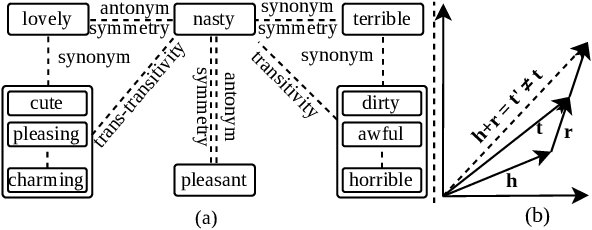
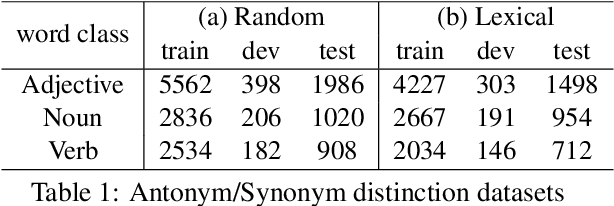

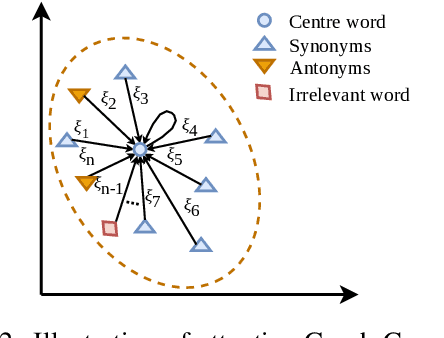
Abstract:Antonyms vs synonyms distinction is a core challenge in lexico-semantic analysis and automated lexical resource construction. These pairs share a similar distributional context which makes it harder to distinguish them. Leading research in this regard attempts to capture the properties of the relation pairs, i.e., symmetry, transitivity, and trans-transitivity. However, the inability of existing research to appropriately model the relation-specific properties limits their end performance. In this paper, we propose InterlaCed Encoder NETworks (i.e., ICE-NET) for antonym vs synonym distinction, that aim to capture and model the relation-specific properties of the antonyms and synonyms pairs in order to perform the classification task in a performance-enhanced manner. Experimental evaluation using the benchmark datasets shows that ICE-NET outperforms the existing research by a relative score of upto 1.8% in F1-measure. We release the codes for ICE-NET at https://github.com/asif6827/ICENET.
BClean: A Bayesian Data Cleaning System
Nov 11, 2023Abstract:There is a considerable body of work on data cleaning which employs various principles to rectify erroneous data and transform a dirty dataset into a cleaner one. One of prevalent approaches is probabilistic methods, including Bayesian methods. However, existing probabilistic methods often assume a simplistic distribution (e.g., Gaussian distribution), which is frequently underfitted in practice, or they necessitate experts to provide a complex prior distribution (e.g., via a programming language). This requirement is both labor-intensive and costly, rendering these methods less suitable for real-world applications. In this paper, we propose BClean, a Bayesian Cleaning system that features automatic Bayesian network construction and user interaction. We recast the data cleaning problem as a Bayesian inference that fully exploits the relationships between attributes in the observed dataset and any prior information provided by users. To this end, we present an automatic Bayesian network construction method that extends a structure learning-based functional dependency discovery method with similarity functions to capture the relationships between attributes. Furthermore, our system allows users to modify the generated Bayesian network in order to specify prior information or correct inaccuracies identified by the automatic generation process. We also design an effective scoring model (called the compensative scoring model) necessary for the Bayesian inference. To enhance the efficiency of data cleaning, we propose several approximation strategies for the Bayesian inference, including graph partitioning, domain pruning, and pre-detection. By evaluating on both real-world and synthetic datasets, we demonstrate that BClean is capable of achieving an F-measure of up to 0.9 in data cleaning, outperforming existing Bayesian methods by 2% and other data cleaning methods by 15%.
GARI: Graph Attention for Relative Isomorphism of Arabic Word Embeddings
Oct 19, 2023Abstract:Bilingual Lexical Induction (BLI) is a core challenge in NLP, it relies on the relative isomorphism of individual embedding spaces. Existing attempts aimed at controlling the relative isomorphism of different embedding spaces fail to incorporate the impact of semantically related words in the model training objective. To address this, we propose GARI that combines the distributional training objectives with multiple isomorphism losses guided by the graph attention network. GARI considers the impact of semantical variations of words in order to define the relative isomorphism of the embedding spaces. Experimental evaluation using the Arabic language data set shows that GARI outperforms the existing research by improving the average P@1 by a relative score of up to 40.95% and 76.80% for in-domain and domain mismatch settings respectively. We release the codes for GARI at https://github.com/asif6827/GARI.
GRI: Graph-based Relative Isomorphism of Word Embedding Spaces
Oct 18, 2023



Abstract:Automated construction of bilingual dictionaries using monolingual embedding spaces is a core challenge in machine translation. The end performance of these dictionaries relies upon the geometric similarity of individual spaces, i.e., their degree of isomorphism. Existing attempts aimed at controlling the relative isomorphism of different spaces fail to incorporate the impact of semantically related words in the training objective. To address this, we propose GRI that combines the distributional training objectives with attentive graph convolutions to unanimously consider the impact of semantically similar words required to define/compute the relative isomorphism of multiple spaces. Experimental evaluation shows that GRI outperforms the existing research by improving the average P@1 by a relative score of up to 63.6%. We release the codes for GRI at https://github.com/asif6827/GRI.
Consistent and Flexible Selectivity Estimation for High-dimensional Data
May 20, 2020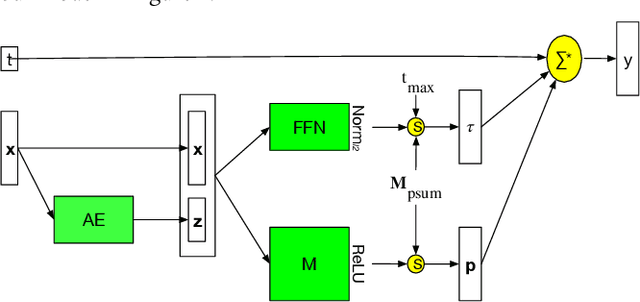
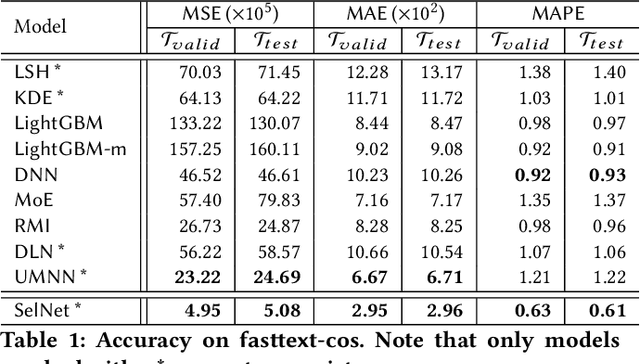
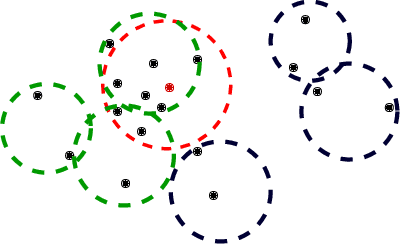
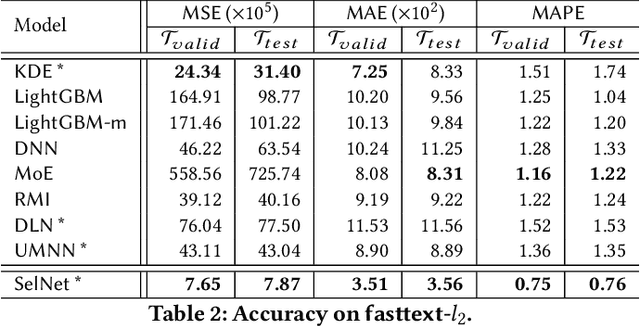
Abstract:Selectivity estimation aims at estimating the number of database objects that satisfy a selection criterion. Answering this problem accurately and efficiently is essential to applications, such as density estimation, outlier detection, query optimization, and data integration. The estimation problem is especially challenging for large-scale high-dimensional data due to the curse of dimensionality, the need to make the estimator consistent (i.e., the selectivity is non-decreasing w.r.t. the threshold), and the large variance of selectivity across different queries. We propose a new deep learning-based model that learns a query dependent piece-wise linear function as the estimator. We design a novel model architecture so that the model is flexible to fit any selection criterion. To improve the accuracy for large datasets, we propose to divide the dataset into multiple disjoint partitions and build a local model on each of them. We perform experiments on real datasets and show that the proposed model guarantees the consistency and significantly outperforms state-of-the-art models in terms of both accuracy and efficiency.
Monotonic Cardinality Estimation of Similarity Selection: A Deep Learning Approach
Mar 18, 2020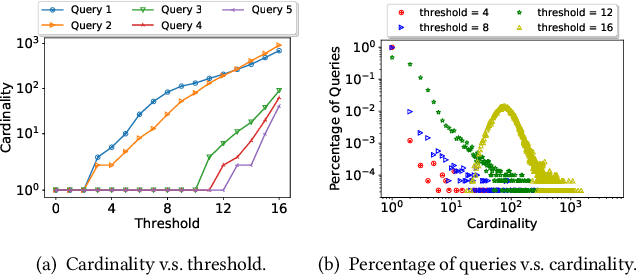
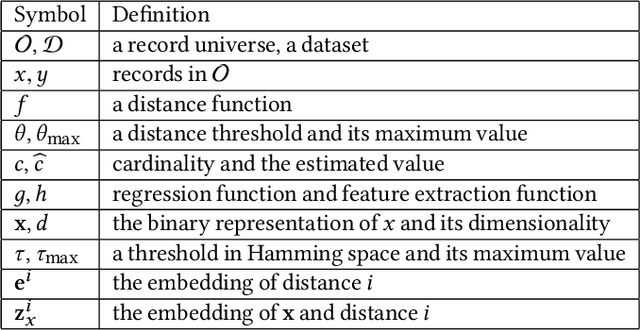
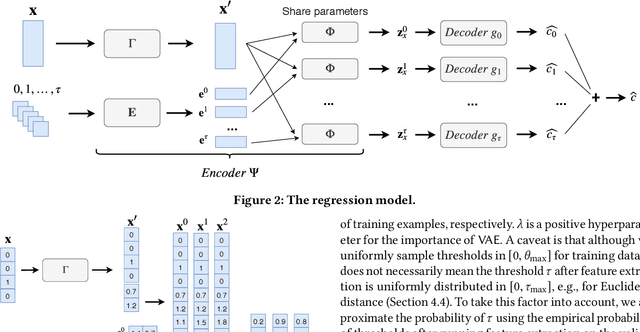

Abstract:Due to the outstanding capability of capturing underlying data distributions, deep learning techniques have been recently utilized for a series of traditional database problems. In this paper, we investigate the possibilities of utilizing deep learning for cardinality estimation of similarity selection. Answering this problem accurately and efficiently is essential to many data management applications, especially for query optimization. Moreover, in some applications the estimated cardinality is supposed to be consistent and interpretable. Hence a monotonic estimation w.r.t. the query threshold is preferred. We propose a novel and generic method that can be applied to any data type and distance function. Our method consists of a feature extraction model and a regression model. The feature extraction model transforms original data and threshold to a Hamming space, in which a deep learning-based regression model is utilized to exploit the incremental property of cardinality w.r.t. the threshold for both accuracy and monotonicity. We develop a training strategy tailored to our model as well as techniques for fast estimation. We also discuss how to handle updates. We demonstrate the accuracy and the efficiency of our method through experiments, and show how it improves the performance of a query optimizer.
 Add to Chrome
Add to Chrome Add to Firefox
Add to Firefox Add to Edge
Add to Edge